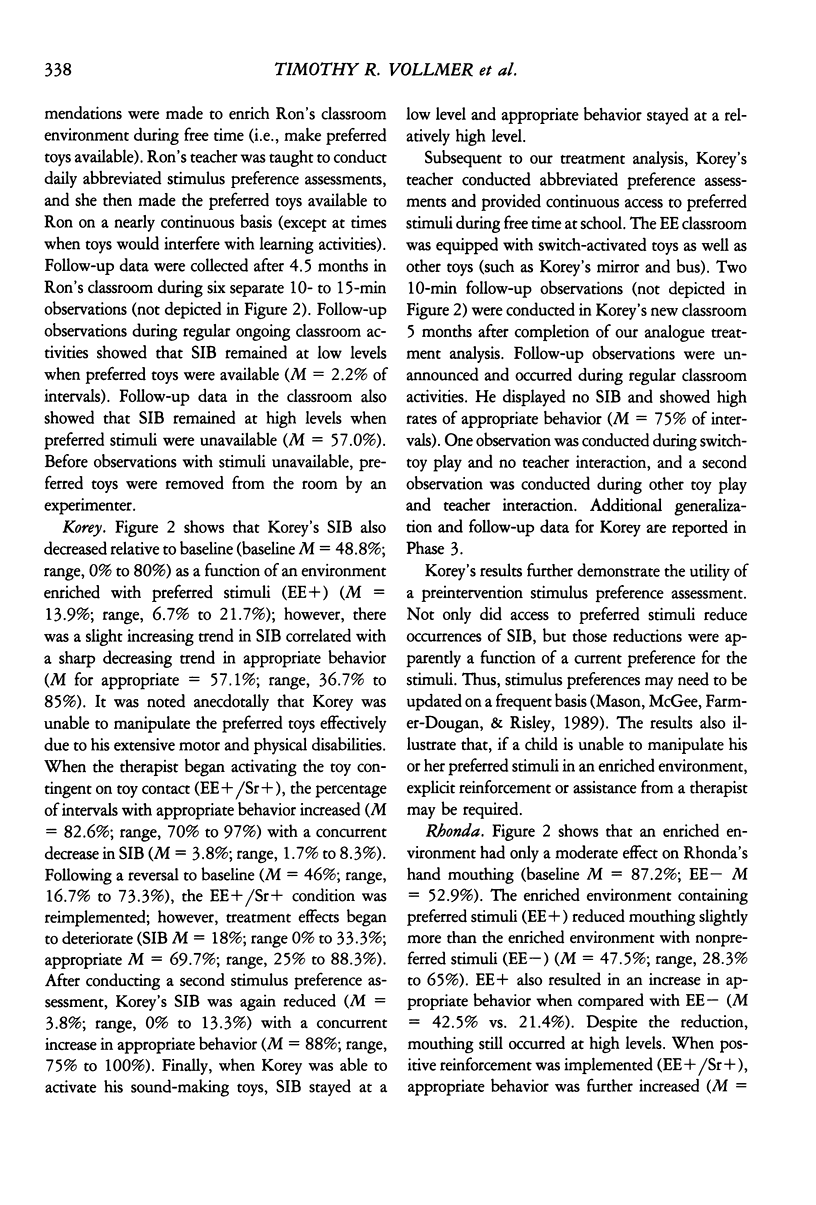Abstract
Numerous studies have used functional analyses to prescribe interventions for severe behavior disorders. The majority of these studies have focused on behavior that is clearly maintained by socially mediated reinforcement, such as contingent access to attention, tangibles, or escape from instructional demands. However, a significant proportion of functional analyses do not yield conclusive results. We examined interventions for 3 children with severe disabilities following inconclusive functional analyses. First, preferred stimuli were identified for each child via a stimulus preference assessment. Second, a functional analysis was conducted for 2 of the 3 children. High rates of aberrant behavior were seen even (if not especially) in no-interaction sessions. The 3rd child was observed for several consecutive no-interaction sessions; behavior persisted in this condition. Third, interventions based on environmental enrichment were analyzed in an analogue setting. For all of the children, environmental enrichment decreased aberrant behavior if preferred stimuli were used in the procedure. To obtain further reductions in aberrant behavior, explicit reinforcement of toy play was required for 2 children, and a brief (5-s) time-out was necessary with 1 child. Finally, effects of treatment carried over to the school or home environment following teacher or family training. Results are discussed in the context of basic reinforcement principles and future directions for research.
Full text
PDF













Selected References
These references are in PubMed. This may not be the complete list of references from this article.
- Carr E. G., Durand V. M. Reducing behavior problems through functional communication training. J Appl Behav Anal. 1985 Summer;18(2):111–126. doi: 10.1901/jaba.1985.18-111. [DOI] [PMC free article] [PubMed] [Google Scholar]
- Deluty M. Z. Choice and the rate of punishment in concurrent schedules. J Exp Anal Behav. 1976 Jan;25(1):75–80. doi: 10.1901/jeab.1976.25-75. [DOI] [PMC free article] [PubMed] [Google Scholar]
- Derby K. M., Wacker D. P., Sasso G., Steege M., Northup J., Cigrand K., Asmus J. Brief functional assessment techniques to evaluate aberrant behavior in an outpatient setting: a summary of 79 cases. J Appl Behav Anal. 1992 Fall;25(3):713–721. doi: 10.1901/jaba.1992.25-713. [DOI] [PMC free article] [PubMed] [Google Scholar]
- Egel A. L. Reinforcer variation: implications for motivating developmentally disabled children. J Appl Behav Anal. 1981 Fall;14(3):345–350. doi: 10.1901/jaba.1981.14-345. [DOI] [PMC free article] [PubMed] [Google Scholar]
- Fisher W., Piazza C. C., Bowman L. G., Hagopian L. P., Owens J. C., Slevin I. A comparison of two approaches for identifying reinforcers for persons with severe and profound disabilities. J Appl Behav Anal. 1992 Summer;25(2):491–498. doi: 10.1901/jaba.1992.25-491. [DOI] [PMC free article] [PubMed] [Google Scholar]
- Horner R. D. The effects of an environmental "enrichment" program on the behavior of institutionalized profoundly retarded children. J Appl Behav Anal. 1980 Fall;13(3):473–491. doi: 10.1901/jaba.1980.13-473. [DOI] [PMC free article] [PubMed] [Google Scholar]
- Iwata B. A., Pace G. M., Dorsey M. F., Zarcone J. R., Vollmer T. R., Smith R. G., Rodgers T. A., Lerman D. C., Shore B. A., Mazalesk J. L. The functions of self-injurious behavior: an experimental-epidemiological analysis. J Appl Behav Anal. 1994 Summer;27(2):215–240. doi: 10.1901/jaba.1994.27-215. [DOI] [PMC free article] [PubMed] [Google Scholar]
- Iwata B. A., Pace G. M., Kalsher M. J., Cowdery G. E., Cataldo M. F. Experimental analysis and extinction of self-injurious escape behavior. J Appl Behav Anal. 1990 Spring;23(1):11–27. doi: 10.1901/jaba.1990.23-11. [DOI] [PMC free article] [PubMed] [Google Scholar]
- Lovaas I., Newsom C., Hickman C. Self-stimulatory behavior and perceptual reinforcement. J Appl Behav Anal. 1987 Spring;20(1):45–68. doi: 10.1901/jaba.1987.20-45. [DOI] [PMC free article] [PubMed] [Google Scholar]
- Mace F. C., Lalli J. S., Lalli E. P. Functional analysis and treatment of aberrant behavior. Res Dev Disabil. 1991;12(2):155–180. doi: 10.1016/0891-4222(91)90004-c. [DOI] [PubMed] [Google Scholar]
- Mazaleski J. L., Iwata B. A., Rodgers T. A., Vollmer T. R., Zarcone J. R. Protective equipment as treatment for stereotypic hand mouthing: sensory extinction or punishment effects? J Appl Behav Anal. 1994 Summer;27(2):345–355. doi: 10.1901/jaba.1994.27-345. [DOI] [PMC free article] [PubMed] [Google Scholar]
- Neef N. A., Mace F. C., Shade D. Impulsivity in students with serious emotional disturbance: the interactive effects of reinforcer rate, delay, and quality. J Appl Behav Anal. 1993 Spring;26(1):37–52. doi: 10.1901/jaba.1993.26-37. [DOI] [PMC free article] [PubMed] [Google Scholar]
- Rincover A. Sensory extinction: a procedure form eliminating self-stimulatory behavior in developmentally disabled children. J Abnorm Child Psychol. 1978 Sep;6(3):299–310. doi: 10.1007/BF00924733. [DOI] [PubMed] [Google Scholar]
- Sandman C. A., Barron J. L., Colman H. An orally administered opiate blocker, naltrexone, attenuates self-injurious behavior. Am J Ment Retard. 1990 Jul;95(1):93–102. [PubMed] [Google Scholar]
- Smith R. G., Iwata B. A., Vollmer T. R., Zarcone J. R. Experimental analysis and treatment of multiply controlled self-injury. J Appl Behav Anal. 1993 Summer;26(2):183–196. doi: 10.1901/jaba.1993.26-183. [DOI] [PMC free article] [PubMed] [Google Scholar]
- Van Houten R. The use of wrist weights to reduce self-injury maintained by sensory reinforcement. J Appl Behav Anal. 1993 Summer;26(2):197–203. doi: 10.1901/jaba.1993.26-197. [DOI] [PMC free article] [PubMed] [Google Scholar]
- Vollmer T. R., Iwata B. A., Zarcone J. R., Smith R. G., Mazaleski J. L. The role of attention in the treatment of attention-maintained self-injurious behavior: noncontingent reinforcement and differential reinforcement of other behavior. J Appl Behav Anal. 1993 Spring;26(1):9–21. doi: 10.1901/jaba.1993.26-9. [DOI] [PMC free article] [PubMed] [Google Scholar]


